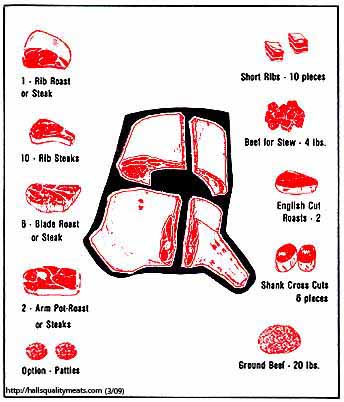
Front Quarter Cuts |

Chuck Meat is basically muscle, and the chuck happens to be a heavily exercised area. Luckily, this area contains a great deal of connective tissue, including collagen. Collagen melts during cooking, making the meat intensely flavorful. Cuts from this area benefit from slow, wet cooking methods like stewing, braising or pot-roasting.
Blade Roast—an inexpensive cut which lies next to the ribs; more tender than most chuck; makes an excellent roast. Alternatively, the roast can be cut into a rib-eye steak, with meat above and below the bone excellent for stir-fry dishes.
Blade Steak—The Chuck Blade Steak is similar to the beef chuck blade roast. It is usually cut less than one inch thick. The blade bone shown in this slide has the typical shape of the "sevenbone", a term frequently used in the meat trade.
Chuck Arm Pot Roast—The Chuck Arm Roast is identified by its thickness as a roast, the large round bone in the center of the cut and the many small muscles of which it is made. This roast may or may not have a cross cut rib bones showing but if present would be at the bottom of the picture.
Cross Rib Pot Roast—This square cut roast comes from the lower corner of the beef chuck. In addition to its square shape this cut is identified by portions of two or three ribs on the underneath side. Note also, the large amount of seam fat located between the muscles.
Tender and flavorful ribs can be cooked any number of ways. Most recipes call for ribs to be roasted, sauteed, pan-fried, broiled, or grilled.
Rib Roast Small End—known as a standing rib roast (bone left in), or without the bone for convenient slicing. Excellent when dry roasted. A seven-bone prime rib roast can be quite a hefty addition to the dinner table. It is great for a crowd, but for a small family a bone roast will do. Many butchers will cut a roast to order for you.
Rib Roast Roll—The bones of the beef rib roast are sometimes removed and the cut is tied in a roll with string as shown in this slide. When this is done the cut is known as a Rib Roast,Boneless. Note that the rib eye muscle runs through the center of the orast and is surrounded by smaller muscles.
Rib Steak —Rib Steaks contain a rib and portion of the backbone. Steaks from the small end of the beef rib contains only the large rib eye muscle while steaks from the large end also contains one or more smaller muscles.
Traditionally used for corned beef, brisket is best prepared with moist heat. Suitable preparation methods include stewing, braising and pot-roasting.
Shank Cross Cut—The Beef Shank Cross Cut is identified by a cross section of the arm bone and many very small muscles, each surrounded by connective tissue.
Brisket Whole—The Beef Brisket is a very course textured muscle. The heavy layer of fat and the sternum or breast bone have been removed. Due to the course texture of this muscle, cooking in liquid is recommended.
Brisket First Cut—a leaner cut of the brisket, for those who want the flavor but not the fat of a brisket pot roast
Brisket Front Cut—fork tender and succulent, a pot roast made with this cut is truly mouthwatering
Short Ribs— Short Ribs are small cubes containing a section of the rib bone and thin layers of muscles. The muscles of the chest perform considerable work and are therefore not very tender.
This section is best used for stew meat, where its rich, beefy flavor can be appreciated.
(3/09)animalscience.unl.edu,(3/09)certifiedangusbeef.com